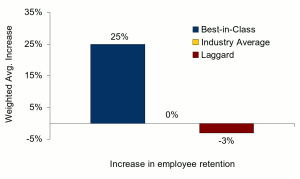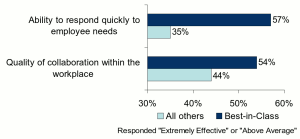
A study conducted by the Aberdeen Group, a Harte-Hanks company, determined that Best-in-Class organizations were able to leverage their investments in mobility to drive significant improvements in customer satisfaction, workforce productivity, and employee retention.
The employee retention benefits discovered point to mobility’s role in recruiting new talent and encouraging existing employees to stay longer. Aberdeen’s newest survey, The State of Wireless LAN 2008, is trying to find out even more about how companies are deploying and optimizing this technology for their workforce, especially as the positive impact on employee retention among the Best-in-Class has been a finding somewhat in contrast with popular wisdom. The phenomenon of the “crackberry,” describing the addictive aspect of mobile, ubiquitous access to enterprise information, is widely understood to represent the negative impact that mobility has historically had on the work/life (work/work?) balance of employees.
The metaphor of the double-edged sword may well apply here: Although it’s undeniable that mobile messaging and collaboration have had a tendency to extend the work day well into what would otherwise be personal time, it has, on the other hand, also given back to the employee the control as to when and where that incursion takes place.
“The benefit of mobile messaging solutions to the employee is peace of mind. When they log in to their computer each morning, they know there won’t be any nasty surprises waiting for them,” said Mark Yunger, director of information technology at Millennium: The Takeda Oncology Company.
Retention and Satisfaction
Figure 1 illustrates the significant benefit that Best-in-Class companies derive as a potential side-effect of their investment in mobile technologies. Although one can’t necessarily draw a direct causal relation between mobility and employee retention, there is a plausible correlation. Especially when compared to Industry Average and Laggard companies.
Figure 2 confirms this correlation by underscoring the notion that top-performing companies take a more holistic view of mobile messaging as it applies to the human capital aspect. Not only have they made efforts to provide mobile messaging functionality upstream and downstream, but they have a strong internal communications infrastructure and are utilizing the workplace flexibility enabled by the technology to promote a happier, more adaptable, and ultimately more productive workforce.
In addition, new hires are entering enterprises from graduate schools and colleges with high mobility expectations and a sense of entitlement to access wherever and whenever needed. By nature a migratory workforce, they’re shopping for career tracks which provide them the best tools to compete in the global marketplace. Although it bears further scrutiny, the fact that Best-in-Class organizations can satisfy their need for 24 / 7 access may well be a factor in workplace satisfaction, resulting in increased loyalty and therefore employee retention.
Soft Benefits
Mobile messaging and collaboration tools provide many benefits to the Best-in-Class enterprises that have implemented them. Among the more obvious and tangible benefits of increased productivity and customer satisfaction are the “softer” benefits of a more satisfied workforce resulting in increased employee retention.
The report was based on survey data from over 233 end-user organizations worldwide, fielded in August 2008.
The following are selected actions recommended by the report You Can Take it with You: Enterprise Mobile Messaging and Collaboration:
- Create a cross-functional team to help identify mobile messaging best practices
- Develop the ability to measure and track mobile messaging usage
- Expand the usage of push e-mail
- Extend mobile messaging and collaboration capabilities throughout the organizational value chain
- Investigate the use of Unified Communications (UC) solutions
- Develop organizational definitions for acceptable mobile devices
- Utilize mobile messaging gateways (mobile middleware) to ensure maximum uptime and secure Over-the-Air (OTA) software and data delivery
Best-in-class organizations realize that there is no single device that will be able to serve all of the needs of a mobile workforce. These organizations, however, are providing a suite of tools and systems, especially for those hires that spend 25 percent of their time on the road. This suite is being put in place to minimize the cost of travel and leverage downtime in order to make them 35 percent more productive than all other organizations that are not providing such tools.
Beyond Tactics
Productivity of mobile workers remains a hot issue as leveraging downtime is ever important. Because Best-in-Class companies show an approximate 35 percent increase in productivity for those workers on the road, it shows that when the appropriate technologies and centralized business processes are in place, the mobile workforce is more productive.
Businesses have to move beyond the tactical approach of adding mobility to their organizational capabilities, especially as the culture changes and adaptations from a younger, mobile culture begin to infiltrate the corporate structure.
In addition to the employee retention benefits, Best-in-Class organizations also achieved a 23 percent increase in customer retention, as compared to a 5 percent increase for Industry Average and no increase for Laggards.
Those Best-in-Class organizations with mobile messaging and collaboration capabilities saw an overall 40 percent increase in employee productivity. Industry Average companies saw an 11 percent increase in employee productivity, while Laggard companies only saw a 1 percent increase.
Best-in-Class is defined as the top 20 percent of aggregate performance scorers, while Industry Average is the middle 50 percent, and Laggards make up the bottom 30 percent of aggregate performance scorers.
To download Aberdeen’s August report, Voice Over WiFi in the Enerprise, click here.
Andrew Borg is a senior research analyst for wireless and mobility at Aberdeen Group.


















































